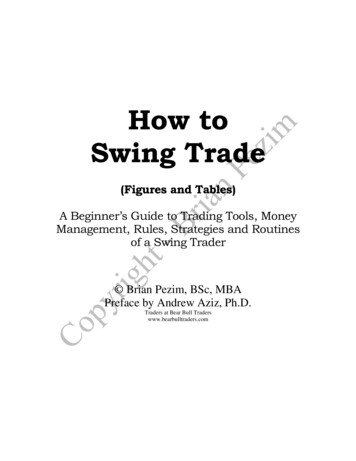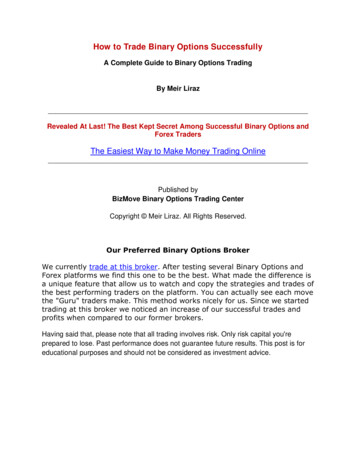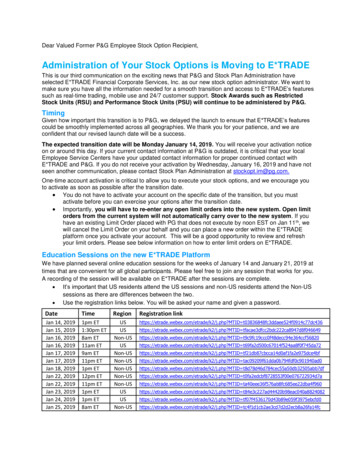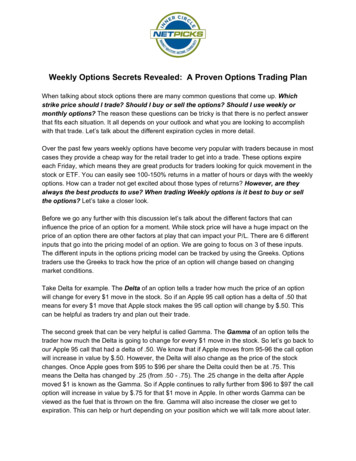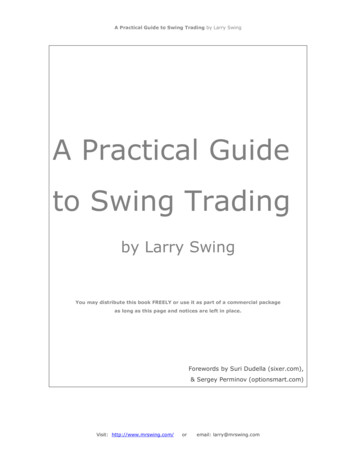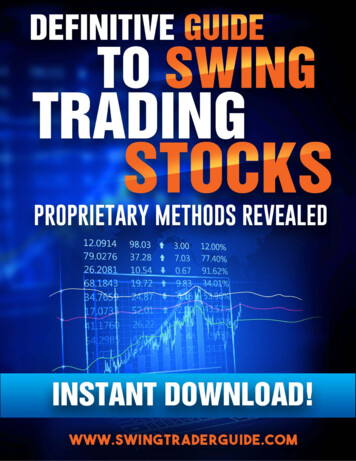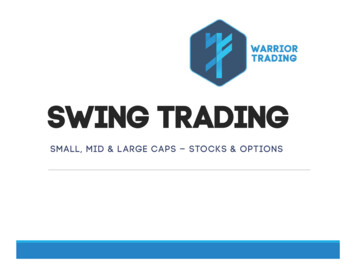
Transcription
Swing TradingS M A L L, M I D & L A RG E CA PS – STO CK S & O PT ION S
Warrior TradingI’m a full time trader and help run a live trading room wherewe trade in real time and teach people how to trade stocks.My primary focus is on Swing Trading, but I day trade aswell. Like a good carpenter, a good trader will have morethan one or two tools in the tool box. As a trader, you shouldlearn several strategies and be able to apply them invarying market conditions.My job as the head swing trader is to handle all of the tradedue diligence, research, analysis, alerts and follow upcommentary. You can subscribe to my TickerTV channel forLIVE watch list building, market analysis, trade review andgeneral Q&A www.ticker.tv/swingtradewarrior
Trading Courses
Swing tradingCHAPTER 1. INTRODUCTION TO SWINGTR ADING AND HOW TO UNDERSTAND AND USEOPTIONS
Course ScheduleDay 1 – Chapter 1: Intro to Swing Trading & Options 101Day 2 – Chapter 2: Options Trading StrategiesDay 3 – Chapter 3: Fundamentals and TechnicalsDay 4 – Chapter 4: Risk ManagementDay 5 – Chapter 5: Stock Trading Strategies & Watch List Building
How does Swing Trading Work?The idea behind swing trading is to capitalize on short term movesof stocks, in any direction, over a period of time.As swing traders, we profit from trends and finding entryopportunities EARLY, before the crowds. (b/o and run vs. scalping)Swing trading is defined as: “a speculative activity in financialmarkets where a tradable asset is held for between one to severaldays in an effort to profit from price changes or 'swingsswings'.”swingsAs traders, it is our job to identify trading opportunities that alignwith our risk parameters, evaluate trade candidates and executetrades with adherence to our rules and strategy. Be a robot!Like day trading, swing trades come from catalysts, events,technical setups and speculative opportunities.
Swing Trading is SIMPLEMany people have a tendency of over complicatingor over thinking swing trades don’t do it. Don’tmicromanage, hover, hope, wish, rationalize or thinkwhen trading. Be a robot. Stick to your plan (have aplan). More on this later Swing Trading is a 3 step process1) Find a trade idea (scanner, news, etc.)2) Develop a plan for the trade idea (analyze entry/exit/target,stop)3) Execute (monitor trade and adjust as needed)
What’s the Difference? Both show abreakout right?
One Chart Was a Daily and the Other was a 5m ChartWhich trade would you want to be in? Why? It depends on goals, risk, size etc.
Why do Most Traders Fail?Day trading requires quick decision making and lots ofdiscipline. Many new traders initially lack the ability to makegood decisions and maintain composure while under thestress of a losing position, and even winning ones. The deer inthe headlights syndrome comes into play!Skill and Discipline are like muscles that require exercise togrow. Your ability to make quick decisions and follow yourtrading rules will improve with experience and understanding.This is why we tell people to paper trade! Practice with fakemoney, not real money.Swing trading can provide income and profits while one worksto develop their day trading ability and build up their mentalgame. Swing trading can be emotionally “easier” when you areplaying by the “rules.” Also, swing trading is great for thoselooking to trade part time due to other full time commitments.Set your orders and walk away!
Swing Trading With Warrior TradingWatch lists, Alerts, Blotter, Varied Strategies and Trade ng-trade-alerts/
Options 101Options can be difficult to understand, but are very effective when usedappropriately. They get a lot of hype, good and badPeople tend to see high % wins on options and fall in love – losses can behigh % also. In some cases, losses could technically be infinite!Options trades are generally for more speculative ideas as they rely onvolatility in most cases, but not always. You can use them to play the trendsFor swing trading, I prefer the simpler uses for options. Basic puts and calls,vertical spreads and iron condors for earnings plays make up my playbookfor optionsThis section is just to give you a basic understanding of the options typesthat I use when swing trading, how and why. We will discuss the right time touse which option, depending on our goals and applicationThere are MANY complicated explanations for options, I will try to keep it assimple and relevant as possible. Most analogies attempt to explainexercise/assignment, which we will almost never do when swing trading,but we still have to be mindful of that risk
Options 101 ContinuedOptions provide financial leverage without needing to useborrowed capital. By investing in options, you can control alarger number of shares for the same initial investment, than ifyou purchased the shares themselves.Options contracts control 100 share lots of a stock. Cannot bepurchased on margin! Cash only. T 1 settlementFor example, if you wish to invest 1 000, you could purchase 10shares of ABC stock (hypothetically) valued at 100 per share.Alternatively, the option contracts may realistically be valued at 200 for lots of 100 shares ( 2.00 per option). For your investmentof 1 000, you could buy five options contracts, increasing yourfinancial leverage by allowing you to control 500 sharesinstead of just 10.Like with anything, too much leverage can be bad and oftengets new traders into big trouble!
Options 101 ContinuedThe price (or cost) of an option is an amount of money knownas the premium. An option buyer pays this premium to anoption seller in exchange for the right granted by the option.Which is, the choice (the "option") to exercise the option orallow it to expire worthlessAn option’s contract is like any other contract, with rights andconditions. They also have expiration dates.The same concepts are at work here as when buying stock forevery buyer, there must be a seller and therefore, liquidity.Two common ways to trade options:- Exercise vs. Assignment (Want to own stock/sell the stock youown)- Flipping them for premium (Want to profit in pricechanges/trade)
Options 101 ContinuedCalls and PutsThe two types of options are calls and puts (both control 100shares of an underlying stock)A call gives the holder the right to buy an asset at a certainprice within a specific period of time. Calls are similar to havinga long position on a stock. Buyers of calls hope that the stockwill increase substantially before the option expires.A put gives the holder the right to sell an asset at a certainprice within a specific period of time. Puts are very similar tohaving a short position on a stock. Buyers of puts hope that theprice of the stock will fall before the option expires.
Options 101 ContinuedParticipants in the Options MarketThere are four types of participants in options marketsdepending on the position they take:Buyers of calls (long/bullish on the stock)Sellers of calls (long stock – covered calls, bearish on thestock)Buyers of puts (short/bearish on thestock/insurance/hedge)Sellers of puts (bullish on the stock/want to own stock belowa certain price)
Options 101 ContinuedStory time!Just like in stock trading, for every buyer, there MUST be a seller!
Options 101 ContinuedStrike Price - The pre-agreed price per share at which stock maybe bought or sold under the terms of an option contract. Somepeople refer to the strike price as the “exercise price”.InIn-TheThe-Money (ITM) - For call options, this means the stock price isabove the strike price. So if a call has a strike price of 50 and thestock is trading at 55, that option is in-the-money.For put options, it means the stock price is below the strike price(remember, puts are bearish). So if a put has a strike price of 50and the stock is trading at 45, that option is in-the-money.OutOut-ofof-TheThe-Money (OTM) - For call options, this means the stockprice is below the strike price. For put options, this means the stockprice is above the strike price. The price of out-of-the-moneyoptions consists entirely of “time value.”
Options 101 ContinuedAtAt-TheThe-Money (ATM) - An option is “at-the-money” when the stock price is equal to thestrike price. (Since the two values are rarely exactly equal, when purchasing optionsthe strike price closest to the stock price is typically called the “ATM strike.”)Intrinsic Value - The amount an option is in-the-money. Obviously, only in-the-moneyoptions have intrinsic value.Time Value - The part of an option price that is based on its time to expiration. If yousubtract the amount of intrinsic value from an option price, you’re left with the timevalue. If an option has no intrinsic value (i.e., it’s out-of-the-money) its ENTIRE worth isbased on time value (makes out of the money options more speculative).Time Decay – Also known as “theta,” is the ratio of the change in an options premiumprice compared to the decrease in time to expiration. As options approach expiration,the time value declines. This is good for sellers/writers, but bad for buyers. Credit vsDebit trades (more on this later).
Options 101 ContinuedExercise - This occurs when the owner of an option invokes the right embedded in the optioncontract. In layman’s terms, it means the option owner buys or sells the underlying stock at the strikeprice, and requires the option seller to take the other side of the trade (enforcing the contract). Wewill rarely ever exercise options or hold them until expiration. In most cases, we want to use optionsto profit quickly from short, volatile moves by flipping the premium (buy low/sell high).Assignment - When you buy an option (a call or a put), you cannot be assigned stock unless youchoose to exercise your option.option Plain and simple, the purchaser of an option contract will alwayshave the choice to exercise the option, but not the obligation to do so. When you sell an option (acall or a put), you will be assigned stock if your option is in the money at expiration.expiration As the optionseller, you have no control over assignment, and it is impossible to know exactly when this couldhappen. Generally, assignment risk becomes greater closer to expiration. With that said, assignmentcan still happen at any time.Open Interest – Open interest will tell you the total number of option contracts that are currentlyopen. These are contracts that have been traded, but not yet liquidated by either an offsetting tradeor exercise/assignment. When you buy or sell an option, the transaction needs to be entered aseither an opening or a closing transaction. If you buy 10 of the NFLX August 100 calls, you are buyingthe calls to "open". That purchase will add 10 to the open interest figure. If you wanted to get out ofthe position, you would sell those same options contract to "close," and open interest would then fallby 10. Selling options as a writer will also add to the open interest. There is no way to determine if theopen interest is reflecting bought or sold (written) calls. OI is used to help determine liquidity andinterest in a particular stock.
Options 101 ContinuedImplied Volatility (IV) - The estimated volatility of a security's price. In general, implied volatility increaseswhen the market is bearish and decreases when the market is bullish. This is due to the common belief thatbearish markets are more risky than bullish markets. Implied volatility is sometimes referred to as "vols." IVWILL increase in the weeks before earnings, causing premiums to be more expensive than if the stock weretrading at the same price during non earnings season. This is the basis for the iron condor strategy. More onthis later.Implied volatility plays a big role in our options strategies. Remember, as options traders, the general rule tofollow is, BUY low IV and SELL high IV. Implied volatility is a measureVolatility measures uncertainty. A higher volatility stock will have a greater potential price range than a lowervolatility stock.Historical Volatility (HV) – is the realized volatility of a security over a known period of time. Generally, HV iscalculated by determining the average deviation of a security from the average price in the given period oftime. Using the standard deviation is the most common way to calculate HV.Put to Call Ratio - When looking at options liquidity, this measurement can help us determine marketsentiment in an underlying security. As the ratio grows larger, this tells us there are more put buyers than callbuyers, and therefore, a more bearish sentiment. Conversely, when the ratio nears .50 or less, it implies abullish sentiment as call buyers are in charge. This ratio, combined with large “sweeps” or relative volume inthe puts or calls, can help to determine institutional sentiment in an underlying security. Retail traders don’tgenerally buy 5,000 calls on the ask for 1.00. So, what is going on there? Is big money moving in? Is therepending news expected? Are they hedging a short? Maybe the put to call ratio can help us determine.
Options 101 ContinuedThe two main components of options premium pricing are IntrinsicValue & Time ValueIntrinsic Value refers to the portion of the premium that is IN THEMONEY.Note: The ONLY options with intrinsic value, are those ITMIntrinsic Value (calls) Underlying Price – Strike PriceIntrinsic Value (puts) Strike Price – Underlying PriceAny premium in excess of the intrinsic value (ITM) is called “timevalue” or Theta (one of the Greeks).
Options 101 ContinuedAssume a call option has a total premium of 10 (buyer pays 10, sellerreceives 10 for each share of the stock. Remember, this would be 1000, since options contracts control 100 shares) If this option has anintrinsic value of 8, that means that its time value would be 2 ( 10 - 8 2)Option Premium Intrinsic Value Time ValueTime Value Option Premium – Intrinsic ValueWhy do you need to know this? It is
Warrior Trading I’m a full time trader and help run a live trading room where we trade in real time and teach people how to trade stocks. My primary focus is on Swing Trading, but I day trade as well. Like a good carpenter, a good trader will have more than one or two tools in the tool box. As a trader, you should learn several strategies and be able to apply them in varying market .
